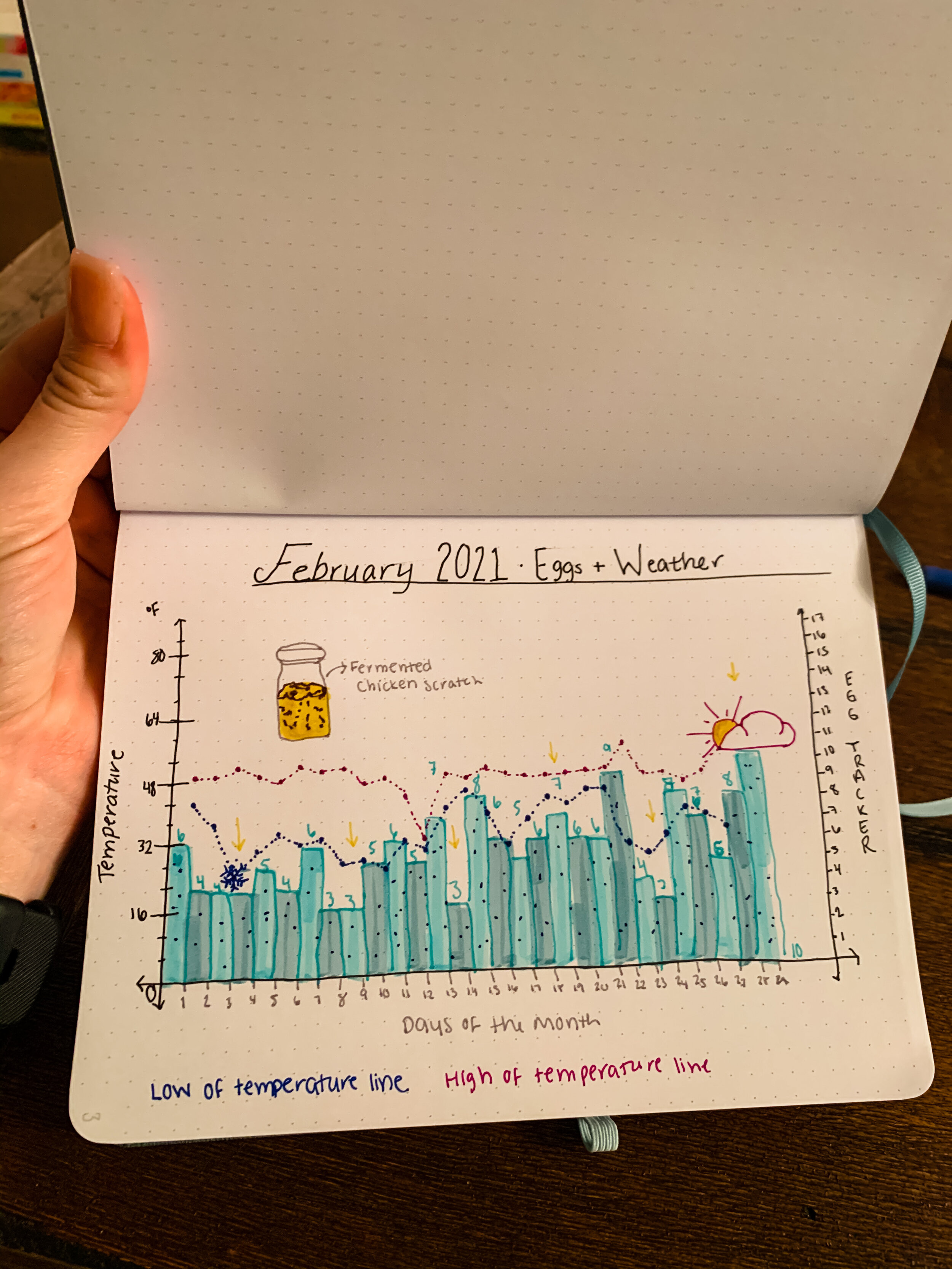Homestead Bullet Journal; February Egg Tracker
Monday, March 01, 2021 - I have always been in love with the concept of bullet journals and, in fact, created by own efficiency planner and tracker out of the concept for my day-to-day multi-hat wearing main job. It seemed like a no-brainer to use the same concept in regards to keeping track and organizing my homesteading goals in a simple way. Strangely, I found it near impossible to find any examples out there on Pinterest and I have yet to see one stumble across my Instagram newsfeed. And, as always, when I can’t find something that I think should exists and it turns out that it doesn’t - I just “make it happen!”
For the first page, I wanted to take my copious amount of stats and notes in regards to my 14 laying hens and their performance during the month of February. Keep in mind, I don’t have lights on my hens and, while they do have access to their outdoor run, it definitely failed in the drainage portion of it’s job causing for a definite “revamp” being added to the spring to-do list! The other unique aspect of this month was the incredible weather swings from freezing rain and downed trees, to sunshine and Cali vibes.
In an effort to keep the hens caloric intake up, I saw a bunch of research and articles on fermenting chicken feed. It’s not sprouting the chicken feed, it’s simply fermenting it - similar to the sourdough starter concept. These extra microbes are supposed to be great for their gut health as well! The research that I found said that a half cup per hen is what you’d want to do if it was a full meal. I didn’t have a receptacle that would fit 7 cups of feed, so I opted instead to feed just a mason jar full every five days to the hens. I didn’t do their normal feed, instead I picked up an organic scratch mix and fed it in supplementation to their normal mixture of crumbles and pellets.
February Weather + Fermented Scratch + Egg Tracker
Explaining the Tracker
On the Y-Axis on the left hand sign (vertical arrow), I put temperature in degrees Fahrenheit. On the Y-Axis on the right side, I put the number of eggs collected that day. Along the X-Axis (horizontal at the bottom), I put each day of the month. The first set of points that I plotted was the actual low of the day and then connected them all with a blue dotted line. The second set of points that I plotted was the actual high of the day and that line was then connected with a maroon dotted line. I then added in the number of eggs collected each day, utilizing two shades of blue so that you could differentiate between each day. I then marked with a yellow arrow those days that the fermented chicken scratch was given to the hens.
What We Learned
While I love running little experiments like this, it’s quite clear that we can’t say that any one thing impacted the hens more than the other without further research and better control of the variables. What I found most interesting is that the days that were the coldest the egg production was the lowest but the biggest telling factor wasn’t the coldest point, it was the coldest high that mattered the most. As you can see on the 12th of February, the high never really got that much above freezing. Remember that eggs take 26 hours to develop so the drop on the 14th could be attributed to the impacts of that cold high temperature of the day. We can also see an interesting twist in weather changes impacting the eggs laid number, while the sunshine definitely helps.
In regards to the scratch, here is something very interesting: egg production improved EVERY DAY after the scratch was fed! Keep in mind, this wasn’t a lot of scratch, about 1/8 cup per hen. With that being said, I am curious to see if the impacts will go up OR if there is a coincidence in chicken egg laying cycles?
In Conclusion…
In conclusion, I am no poultry scientist and none of this should be taken as gold. I am going to be gone the first week of March so utilizing scratch this week seems unlikely. However, I am improving the data chart to include daylight hours as well to record that variable as well. As we move into spring, I am excited to see my hens continue to produce more for my family, extended families and community!
Have you ever run experiments to see what works best for your animals? If so, please let me know in the comments below or on my Facebook or Instagram page! I am very curious to see what you have found to be the best for your laying hens, especially those in the northwest!
